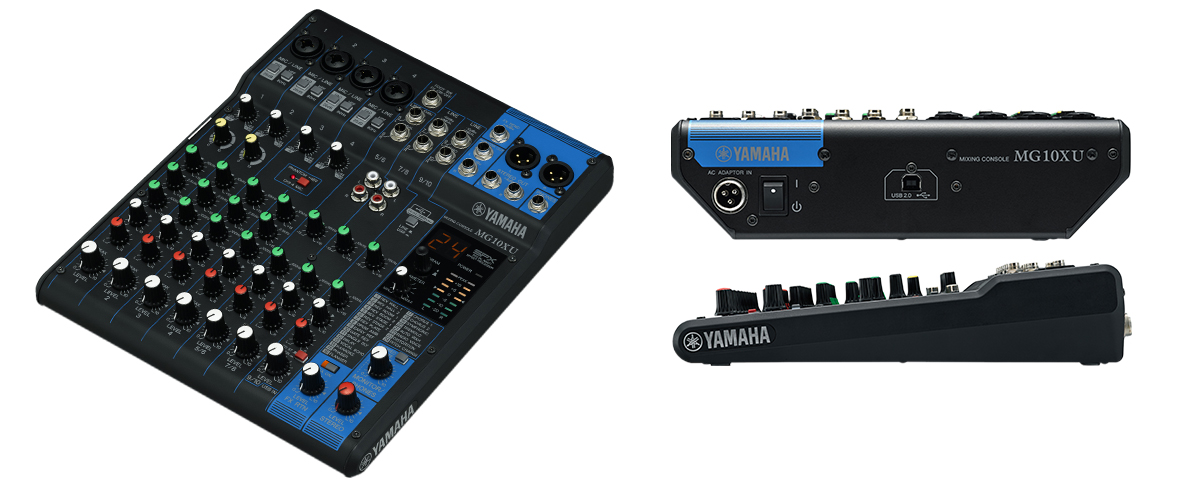As working from home continues it is becoming more and more important for DJs and artists to make sure their online audio and video are the best quality they can be. Setting up a home studio area will allow you to more easily create content that sounds and looks amazing. One of the most important parts of a home studio is an audio interface that will allow your equipment, be it a microphone, DJ controller, or guitar, to connect to your computer. These devices convert the analog signal from your gear into a digital signal that your computer can understand. If you’re not sure where to start, here are 4 great options to check out.


Mackie Onyx Producer 2-2
On the lower end of the cost spectrum, we have the Mackie Onyx Producer 2-2. This compact interface is still full-featured, offering two microphone inputs that can easily be flipped to a Hi-Z input for instruments like a guitar. The inputs can accept both XLR and TRS (a must these days) and you can monitor your mix via the headphone output. One unique feature, especially at this price point, is MIDI in and out functionality that will allow you to plug in a synth, controller, or sequencer to the interface as well. All of this is built inside of a metal box for durability and powered via the USB cable. Mackie also includes the Tracktion T7 DAW software and 16 effects, so you will have a program to work with right out of the box.
If you are new to recording and streaming, the Mackie may be a great starting point for you.


Focusrite Scarlett 2i2
Next on our list is the Focusrite Scarlett 2i2. A lot of the same features we saw in the Mackie are also found on the Scarlett, including combo XLR/TRS inputs with an instrument switch. Something not seen on the Mackie, however, is Scarlett’s “Air” setting, which gives vocal and acoustic recordings a brighter and more open sound. If you’re new to recording or using an audio interface, being able to quickly apply a setting like this will save you time tweaking EQ and effects and allow you to get recording more quickly.
The Scarlett automatically detects whether you have plugged in an XLR or TRS and justs the gain accordingly, a nice touch to see. One thing to note is that the full gain range for the microphone preamp is only available when using an XLR cable, so make sure you are opting for that over TRS. Another great feature of the Scarlett is the “gain halo,” a glowing ring around the gain know that changes color depending on whether or not an input is clipping or close to clipping. Included in the box are two lite versions of the widely popular software options Ableton Live and Pro Tools.
If you want maximum simplicity and ease of use, the Scarlett is a great option.


Steinberg UR24C
The Steinberg UR24C is another affordable and compact audio interface that offers a 2IN/4OUT configuration. While I was disappointed that only one of the 2 inputs has an HiZ switch for instruments, I was happy to see that the 4 outputs could be used, for example, to connect two pairs of studio monitors to more thoroughly check your mixes. The main outputs are TRS while the line outputs are RCA. On the back you’ll find both USB and 5V DC connections, so you can choose to power it from your computer or the wall.
The UR24C has some pretty unique features that I haven’t seen on other audio interfaces. For example, its dual monitor modes (DAW and DJ) work equally well in both a recording or a live environment. DJ mode allows users to choose between split or stereo monitoring. The Loopback function is perfect for audio streaming over the internet – it mixes the audio inputs with the DAW software playback and sends them back into the computer. Finally, its ability to connect to an iPhone or iPad means that you can mix and record on the go more easily.
If you want a more capable interface that offers versatility in a compact form factor then the UR24C may be the best option.


Yamaha MG10XU
Lastly, we have the Yamaha MG10XU. The MG10XU is a somewhat different audio interface – in fact, it’s actually a live sound mixer with USB connectivity. This has a lot of advantages over the other interfaces we have already talked about. You get a full 10 channels of input, giving you the freedom to mix larger groups or bands. Each channel also has controls like a 3 band EQ, balance, and effects that allow you to shape the sound to your liking before it ever gets to your computer. Channels 1 and 2 also include a one-knob compressor, a powerful tool for vocals and instruments alike. A high pass filter removes low-frequency noise that can muddy up a mix.
Features seen in the previous two interfaces like XLR/TRS combo inputs, phantom power, and a metal chassis are also present here. It’s important to note that while you have up to 10 channels of inputs available, all audio is transmitted to the computer in a stereo signal – there’s not multitrack recording available.
At the end of the day, this is a live sound mixer with USB thrown in and it is not as streamlined for connecting to streaming software or a DAW as other interfaces. However, if maximum inputs and control over your sound with a physical mixer are important, the MG10XU is one of the most affordable mixers with this functionality.
 How Can We Help?
How Can We Help?












